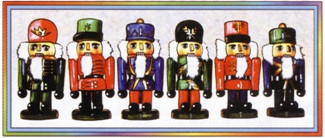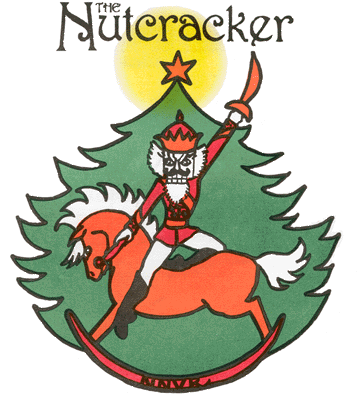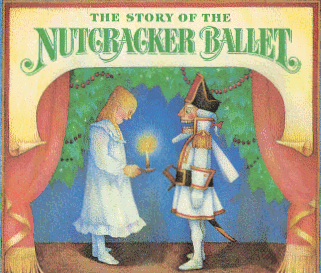|
 The Nutcracker Story
The Nutcracker Story
Ernst Theodor Amadeus Hoffmann - 1816
The first scene occurs at the house of a well-to-do family in a small
town in Germany. The President of the Town Council, Herr Silberhaus, and
his wife are having a party for their family and friends. Councilor
Drosselmeyer, an eccentric but kindhearted old man arrives and
distributes presents to the children. Among her gifts, Clara, President
Silberhaus’ daughter, receives a nutcracker in the shape of a man that
cracks nuts between his jaws. Clara’s brother snatches the nutcracker
from her and breaks it, leaving Clara heartbroken.
After the guests depart and Clara has gone to bed, she cannot forget
the broken nutcracker. She creeps downstairs and when the clock strikes
midnight, she is startled to see mice appearing from all corners of the
living room. Clara watches in amazement as soldiers and the nutcracker
come to life to battle the mice. The fighting reaches a climax when
Clara strikes the Mouse King to the floor with her slipper. With their
leader fallen, the mice disperse. The victory that Clara has brought
about breaks the spell on the nutcracker, transforming him into a
gallant prince. Turning to her gratefully, the prince invites Clara to
accompany him to the Kingdom of the Sweets, where the Sugar Plum Fairy
reigns as queen.
Clara and the Prince have reached the Kingdom of the
Sweets and are received in the great hall of the Sugarplum Fairy’s
castle. When the Prince reveals how Clara saved his life, the entire
court greets her with acclaim. Clara is escorted to a miniature throne
to view the presentation that has been prepared in her honor. Delicacies
of the Kingdom of the Sweets appear. Chocolate, coffee and tea are
represented by Spanish, Arabian and Chinese dancers. Other dances follow
– a lively Russian trepak, dance of the merlitons (penny whistles),
Mother Ginger (the French equivalent of the Old Woman who lived in a
shoe) and her children, the beautiful Waltz of the Flowers, and the
great pas de deux by the Sugar Plum Fairy and her Cavalier. In the
finale, the courtiers of the kingdom kneel in homage to Clara for
rescuing their Prince. The ballet concludes with a brilliant waltz.
http://www.berkshireballet.org/bb_nutpnotes.html

 Nøddeknækkeren og Musekongen
Nøddeknækkeren og Musekongen
Ernst Theodor Amadeus Hoffmann - 1816
Det er juleaften hos familien Stahlbaum, og der kommer gæster. En af
dem er onkel Drosselmeier, som både er spændende og lidt uhyggelig.
Drosselmeier er Claras gudfader, og han har gaver med til alle børnene
og til Clara er er en stor nøddeknækker i form af en soldat. Da den
går i stykker, trøster Clara den, og giver den sin yndlingsdukkes seng.
Gæsterne går og børnene skal i seng. Clara lister op og ser til den
syge nøddeknækker. Den lyser mærkeligt. Store mus kommer frem og
slås mod legetøjssoldaterne, anført af nøddeknækkeren. Clara kaster
en sko efter musekongen, som dør. Så bliver nøddeknækkeren til en
smuk prins, som tager Clara med til sit kongerige.
De kommer til Bolchelandet og bliver modtaget af Sukkerfeen. Der
bliver holdt en stor fest til ære for Clara, som tak for at hun frelste
prinsen. Der er mange forskellige danse ved festen. Den sidste er en
stor blomstervals. Bolchefeens dans kommer lige inden ballettens
slutning, hvor Clara er blevet en unge pige og får sin prins.

Lo Schiaccianoci
Ernst Theodor Amadeus Hoffmann - 1816
Tutti, o quasi, conoscono il balletto Lo Schiaccianoci. In meno sanno
che è tratto da un racconto ancora più antico del balletto. Questo
racconto è stato scritto nel 1816 da uno scrittore romantico tedesco di
nome Ernst Theodor Wilhelm Hoffmann (che però cambiò il Wilhelm in
Amadeus in onore di Wolfgang Amadeus Mozart, di cui era un grande
ammiratore).
Il signore qui a sinistra è, appunto, E.T.A. Hoffmann.
Il balletto Lo Schiaccianoci, invece, è nato in Russia nel 1892 su
coreografie di Marius Petipa (uno dei più grandi coreografi di danza
classica mai esistiti) e musiche di Pëtr Ilic Cajkovskij (che potrai
trovare anche scritto Tchaikovsky, si pronuncia comunque Ceikòski).
La storia del racconto di Hoffmann è abbastanza complessa, ma se tu
prima conoscevi solo la storia del balletto noterai che ci sono molte
differenze tra il balletto e il racconto. Vediamole.
Molti si riferiscono al balletto Schiaccianoci come al capolavoro di
Cajkovskij, forse la sua creazione più famosa, ma lui non sarebbe stato
per nulla d'accordo con quest'affermazione. Infatti in questo spettacolo
tutto gira attorno ai passi di danza. Marius Petipa creò per prima cosa
la coreografia, e poi diede a Cajkovskij tutte le indicazioni necessarie
per scrivere la musica, comprese istruzioni precise sulla durata di ogni
singolo passaggio. In pratica non gli lasciò molta libertà creativa,
per questo a Cajkovskij non piacevano molto le musiche che scrisse per
questo balletto.
Nel racconto la protagonista si chiama Marie e nel balletto, tutti lo
sanno, prende il nome di Clara. Ma questa non è l'unica differenza.
Anche la trama è stata molto semplificata fino a diventare un semplice
pretesto per i numeri di danza, che sono molti. Ecco, in breve, la trama
del balletto Schiaccianoci.
Siamo in casa di Clara, che è una bambina anche se è una ballerina
adulta a interpretarla, la sera della vigilia di Natale. C'è una grande
festa in corso e ogni personaggio danza, insieme o da solo. Poi arriva
il padrino Drosselmeier (o Drosselmeyer, che comunque si legge
Drosselmàier) che porta con sé strane bambole animate, ognuna delle
quali esegue un balletto "caratteristico" (la danza spagnola,
la danza del tè, la danza del cioccolato e così via...).
Tra i giochi Clara trova uno schiaccianoci che attira subito la sua
attenzione.
Nel cuore della notte i topi attaccano i giocattoli di Clara, e i
giocattoli, capitanati dallo Schiaccianoci che nel frattempo si è
animato (prima veniva impiegato un pupazzo, ora c'è un ballerino)
combattono a loro volta contro i topi.
Clara sconfigge il Re dei Topi lanciandogli addosso una ciabatta.
I topi sono sconfitti e l'incantesimo si spezza. Lo Schiaccianoci
diventa un principe e porta Clara nella Foresta Incantata, dove
assistiamo a molte altre danze caratteristiche, tra cui la danza dei
fiocchi di neve, che vedi nella foto a sinistra, e il famosissimo valzer
dei fiori, fino al gran finale dove Clara e il Principe Schiaccianoci
danzano insieme.
Alla fine di tutte le danze ci ritroviamo nel salotto che avevamo
lasciato, dove Clara si sveglia: era stato solo un sogno (mentre nel
racconto tutti accusano Marie di essersi sognata l'intera storia, ma
alla fine si scopre che era tutto vero, anche le cose più strane).
Insomma, le differenze tra balletto e racconto sono tante. Però una
cosa importante in comune ce l'hanno: entrambe sono storie natalizie
dall'inizio alla fine!
http://ilnostronatale.altervista.org/jazzgigi/schiaccianoci_story.html


"Nussknacker und Mäusekönig"
Ernst Theodor Amadeus Hoffmann - 1816
An Heiligabend wartet Marie Stahlbaum mit ihrer Familie auf die
Bescherung des Christkindes. Sie erhalten viele Genschenke, unter
anderem bekommt Fritz, Maries kleinerer Bruder, neue Husare und eine
neue Kavallerie geschenkt. Marie bekommt eine neue Puppe und einen
Nußknacker von ihrem Paten Droßelmeier geschenkt. Die Kinder spielen
mit ihren neuen Spielsachen und sind ganz glücklich. Nachdem die Kinder
zu Bett gegangen sind, wird Marie durch Geräusche im Wohnzimmer geweckt
und geht nachsehen. Sie beobachtet im Wohnzimmer in einen Kampf zwischen
dem Nussknacker, der verzaubert ist, und dem Mäusekönig. Das
Puppenreich, dessen Prinz der Nussknacker ist, erwacht immer dann zum
Leben, wenn die Uhr gehindert wird zwölf zu schlagen. Sie gerät
zwischen die Kämpfenden. Der Mäusekönig bedroht Marie, sie weicht
zurück und dabei fällt sie in den Glasschrank im Wohnzimmer. Da sie
sich am Glasschrank geschnitten hatte, muss sie die nächsten Tage im
Bett bleiben. Jede Nacht erhält sie nun Besuch vom Mäusekönig, der
sie zwingt ihm immer wieder Süßigkeiten hinzustellen, die er dann mit
seinem Volk fressen kann. Sie erzählt das Gesehene ihren Eltern und
auch ihrem Paten Droßelmeier. Ihr Pate erzählt ihr dann „Das
Märchen von der harten Nuss“, das Marie für eine wahre Geschichte
hält. Sie ist der Meinung, dass ihr Pate Droßelmeier der Uhrmacher des
Königs ist und der Neffe des Uhrmachers der verzauberte Nussknacker ist.
Marie will dem Nussknacker selbstverständlich helfen. An diesem Abend
erscheint der Nussknacker bei Marie und bittet sie um ihre Hilfe. Der
Nussknacker möchte ein Schwert, um den Mäusekönig töten zu können.
Marie gibt ihm ein Schwert von den Husaren ihres Bruders. Der
Nussknacker tötet den Mäusekönig in der folgenden Nacht und als
Beweis bringt er Marie die sieben Kronen des Mäusekönigs mit. Um sich
bei Marie zu bedanken nimmt er Marie mit ins Puppenreich, um ihr seine
Welt zu zeigen. Marie ist begeistert von dem Puppenreich und fühlt sich
dort wie zu Hause. Nachdem sie aus dem Puppenreich wieder zurückgekehrt
ist, erzählt sie alles ihren Eltern, die sie dann aber auslachen und
ihr nicht glauben. Sie versucht es mit Hilfe der sieben Kronen zu
beweisen, doch ihr Pate Droßelmeier behauptet er habe ihr die Kronen
bereits vor Jahren geschenkt. Marie ist völlig hilflos. Sie ist nun
total in sich gekehrt und träumt hin und wieder von ihren Erlebnissen
im Puppenreich, da sie es niemandem erzählen kann.
Immer wieder unterhält sich Marie mit dem Nussknacker. Eines dieser
Gespräche hört auch ihr Pate Droßelmeier. Dabei passierte es. Es gab
einen Knall und Marie viel ohnmächtig vom Stuhl. Als sie wieder zu sich
kam, stellte man ihr den Neffen ihres Paten vor. Er war der Nussknacker,
der durch den Wunsch von Marie wieder seine alte Gestalt annehmen konnte.
Er bedankte sich bei Marie, weil sie so viel Vertrauen zu ihm hatte und
es ihr egal war wie er aussieht. Er bat Marie um ihr Hand und von nun an
regierten sie gemeinsam das Puppenreich.
http://www.lerntippsammlung.de/Nussknacker-und-M-ae-usek-oe-nig-von-E-.-T-.-A-Hoffmann.html
|
